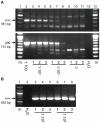Absence of XMRV in peripheral blood mononuclear cells of ARV-treatment naïve HIV-1 infected and HIV-1/HCV coinfected individuals and blood donors
- PMID: 22348082
- PMCID: PMC3278456
- DOI: 10.1371/journal.pone.0031398
Absence of XMRV in peripheral blood mononuclear cells of ARV-treatment naïve HIV-1 infected and HIV-1/HCV coinfected individuals and blood donors
Abstract
Background: Xenotropic murine leukemia virus-related virus (XMRV) has been found in the prostatic tissue of prostate cancer patients and in the blood of chronic fatigue syndrome patients. However, numerous studies have found little to no trace of XMRV in different human cohorts. Based on evidence suggesting common transmission routes between XMRV and HIV-1, HIV-1 infected individuals may represent a high-risk group for XMRV infection and spread.
Methodology/principal findings: DNA was isolated from the peripheral blood mononuclear cells (PBMCs) of 179 HIV-1 infected treatment naïve patients, 86 of which were coinfected with HCV, and 54 healthy blood donors. DNA was screened for XMRV provirus with two sensitive, published PCR assays targeting XMRV gag and env and one sensitive, published nested PCR assay targeting env. Detection of XMRV was confirmed by DNA sequencing. One of the 179 HIV-1 infected patients tested positive for gag by non-nested PCR whereas the two other assays did not detect XMRV in any specimen. All healthy blood donors were negative for XMRV proviral sequences. Sera from 23 HIV-1 infected patients (15 HCV(+)) and 12 healthy donors were screened for the presence of XMRV-reactive antibodies by Western blot. Thirteen sera (57%) from HIV-1(+) patients and 6 sera (50%) from healthy donors showed reactivity to XMRV-infected cell lysate.
Conclusions/significance: The virtual absence of XMRV in PBMCs suggests that XMRV is not associated with HIV-1 infected or HIV-1/HCV coinfected patients, or blood donors. Although we noted isolated incidents of serum reactivity to XMRV, we are unable to verify the antibodies as XMRV specific.
Conflict of interest statement
Figures




Similar articles
-
Prevalence of xenotropic murine leukemia virus-related virus infection in different risk populations in Spain.AIDS Res Hum Retroviruses. 2012 Sep;28(9):1089-94. doi: 10.1089/AID.2011.0149. Epub 2012 Feb 21. AIDS Res Hum Retroviruses. 2012. PMID: 22206583
-
Absence of detectable xenotropic murine leukemia virus-related virus in plasma or peripheral blood mononuclear cells of human immunodeficiency virus type 1-infected blood donors or individuals in Africa.Transfusion. 2011 Mar;51(3):463-8. doi: 10.1111/j.1537-2995.2010.02932.x. Epub 2010 Nov 15. Transfusion. 2011. PMID: 21077909 Free PMC article.
-
Lack of the detection of XMRV or polytropic MLV-related sequences in blood cells from HIV-1-infected patients in Spain.J Acquir Immune Defic Syndr. 2012 Feb 1;59(2):101-4. doi: 10.1097/QAI.0b013e318238b596. J Acquir Immune Defic Syndr. 2012. PMID: 21963942
-
Distribution of xenotropic murine leukemia virus-related virus (XMRV) infection in chronic fatigue syndrome and prostate cancer.AIDS Rev. 2010 Jul-Sep;12(3):149-52. AIDS Rev. 2010. PMID: 20842203 Review.
-
Xenotropic Murine Leukemia Virus-Related Virus (XMRV) and the Safety of the Blood Supply.Clin Microbiol Rev. 2016 Oct;29(4):749-57. doi: 10.1128/CMR.00086-15. Clin Microbiol Rev. 2016. PMID: 27358491 Free PMC article. Review.
Cited by
-
Emerging infectious agents and the nation's blood supply: responding to potential threats in the 21st century.Transfusion. 2013 Feb;53(2):438-54. doi: 10.1111/j.1537-2995.2012.03742.x. Epub 2012 Jun 13. Transfusion. 2013. PMID: 22690676 Free PMC article. No abstract available.
-
No biological evidence of XMRV infection in cervical smears from HIV/ HPV positive and negative Kenyan women.PLoS One. 2012;7(10):e47208. doi: 10.1371/journal.pone.0047208. Epub 2012 Oct 8. PLoS One. 2012. PMID: 23056612 Free PMC article.
-
Recombinant origin, contamination, and de-discovery of XMRV.Curr Opin Virol. 2012 Aug;2(4):499-507. doi: 10.1016/j.coviro.2012.06.009. Epub 2012 Jul 19. Curr Opin Virol. 2012. PMID: 22818188 Free PMC article. Review.
-
The saga of XMRV: a virus that infects human cells but is not a human virus.Emerg Microbes Infect. 2014 Apr;3(4):e. doi: 10.1038/emi.2014.25. Epub 2014 Apr 9. Emerg Microbes Infect. 2014. PMID: 26038516 Free PMC article. Review.
References
-
- Lombardi VC, Ruscetti FW, Das Gupta J, Pfost MA, Hagen KS, et al. Detection of an Infectious Retrovirus, XMRV, in Blood Cells of Patients with Chronic Fatigue Syndrome. Science. 2009;326:585–589. - PubMed
Publication types
MeSH terms
Substances
Grants and funding
LinkOut - more resources
Full Text Sources
Medical
Research Materials

